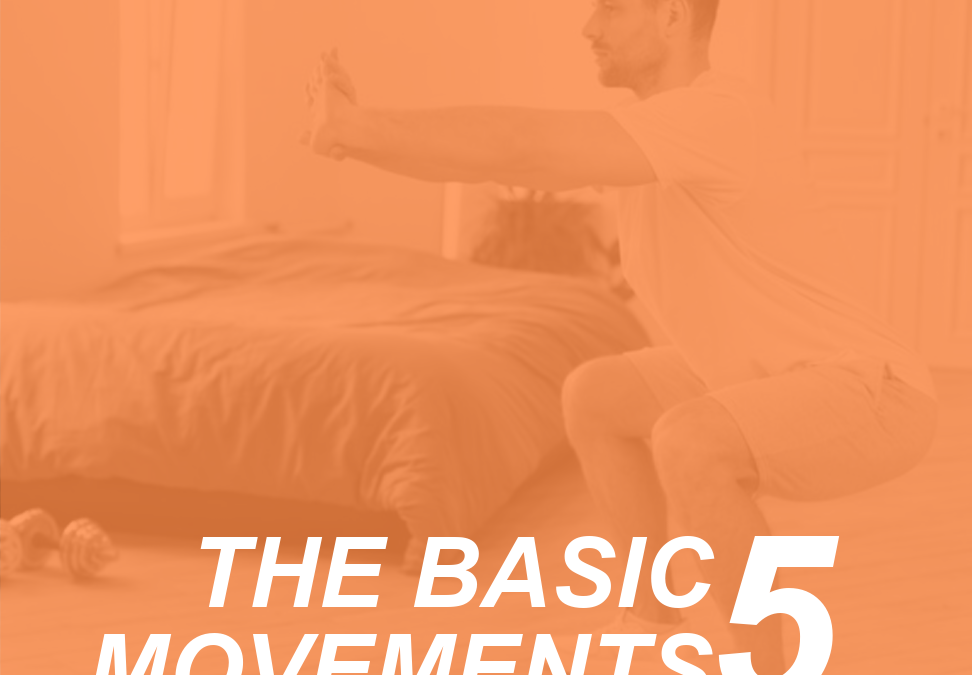When it comes to exercise programming and workout design, the basics still work despite what fit-influencers want consumers to believe. As exercise professionals, we should be mindful of balancing workout programs with challenging tasks and supporting those tasks with basic foundational movements. A quality exercise plan does not require overly complex movements or a wide variety of equipment, or even space. Of course, what each individual client workout program needs depends on the clients’ goals and if they are performance/skill-based or focused on improving general function, efficiency, and fitness. There are five basic movement patterns every client must master prior to moving forward with more complicated and advanced exercises.
The Basic Five
Before we start adding resistance or load to a client’s body, we first need to ensure they can move efficiently and with good form. There are five basic movement patterns exercise professionals should evaluate to determine movement efficiency, range of motion, and form.
- Bend-and-lift. This is probably the most common movement clients perform each day and in multiple unconscious ways. We see this motion during motions that require sit-to-stand, bending down to pick up an object or a small child. These types of movement require adequate hip and knee range of motion, and the ability to hinge properly.
- Single-leg. These motions require balance. Examples of single-leg movements clients perform daily include walking up and down stairs or taking a step forward and reaching toward the ground with one arm (i.e., to retrieve an object).
- Pushing: Pushing movements are interesting as they can occur in four different directions. A forward direction is used when pushing open a door or window. Pushing occurs in an overhead direction when an individual places something on top of a high shelf. Laterally, a client performs this when moving from a side-lying to sitting position. The fourth direction is downward, such as lifting oneself up and out of a pool. These movements require adequate shoulder mobility and strength.
- Pulling: Clients perform pulling movements when opening a door or even climbing a ladder.
- Rotational: These movements involve the trunk and occur when an individual pitches a ball or rotates in the seat of a car (as in backing out of a parking space).
(ACE, 2020)
The Value of the Basic Five
These five movements are reflected in everyday actions – or activities of daily living. If a client is unable to move efficiently or effectively using these basic movement patterns, they are most likely compromising postural and joint stability – neither of which supports fitness goal achievement. This also means a client would not be able to perform load-based exercises due to postural or joint instability. If these movements are not mastered prior, performing more complex movements could lead to injury and a setback toward the client’s intended goals.
Incorporating the Basic Five
Integrating these five basic movements into a client’s routine does not need to require much additional time or effort. Program a movement-prep (following a dynamic warm-up) sequence that includes bodyweight exercises reflective of the basic five. A sample sequence is provided for you below.
3-Minute Dynamic Warm-up
- Jumping jacks or step-outs (30 seconds)
- High knee marches (30 seconds)
- Side shuffles (to the right and back to the left) (30 seconds)
- Arm circles forward and backward (alternating) (30 seconds)
- Wall slides (30 seconds)
- Spinal rotations (30 seconds)
Movement Prep Sequence
- Body-weight squats (8-10 reps)
- Alternating forward lunges (5 each leg)
- Alternating rear lunges (5 each leg)
- Negative push-ups (slower pace on the downward motion, press up quickly – 5 total)
- Standing band pulls with light resistance (8 reps)
- Quadruped thoracic rotation (5 reps each side)
You can regress or progress any of the movements in this sequence.
Suggested Regressions
- Wall-sits
- Static lunges (right foot forward)
- Static lunges (left foot forward)
- Wall push-ups
- Scapular retraction and protraction
- Repeat spinal rotations from the warm-up (or perform torso rotation in a seated position)
Suggestion Progressions
- Body-weight squats using balance discs
- Tick-tock lunges (forward, side, rear – repeat on other leg)
- Negative push-ups with alternating leg raise or diamond push-ups
- Push-ups with feet on a stability ball can be a unique challenge
- Resistance band bent over-over-rows
- Prone scapular pulls (lat pulldown motion) with slight spinal extension
- Alternating rotational slams with light medicine ball
Following the movement prep and depending on your client’s abilities, you can move forward into the conditioning segment of the workout. For some clients, this may be enough if they have compromised ability, range of motion, or postural stability.
Effective exercise designs do not require complex methodologies for most apparently healthy clients who are interested in improving their overall fitness and function. Begin by evaluating your clients’ range of motion, postural stability, and overall movement patterns. Address the areas of greatest need or dysfunction by incorporating the basic five movement patterns consistently. Once a client master’s these movements, they are ready for increased resistance and more challenging experiences (remember, challenging does not mean complicated). Continue to use the basic five as component of your exercise program design. The basics still work, and they work well for all clients.
[sc name=”masterfitness” ][/sc]
References
ACE (2020). The Exercise Professional’s Guide to Personal Training
Dr. Erin Nitschke, NFPT-CPT, NSCA-CPT, ACE Health Coach, Fitness Nutrition Specialist, Therapeutic Exercise Specialist, and Pn1 is a health and human performance college professor, fitness blogger, mother, and passionate fitness professional. She has over 15 years of experience in the fitness industry and college instruction. Erin believes in the power of a holistic approach to healthy living. She loves encouraging her clients and students to develop body harmony by teaching focused skill development and lifestyle balance. Erin is also the Director of Educational Partnerships & Programs for the NFPT. Erin is an editorial author for ACE, IDEA, The Sheridan Press, and the Casper Star Tribune. Visit her personal blog at belivestaywell.com


